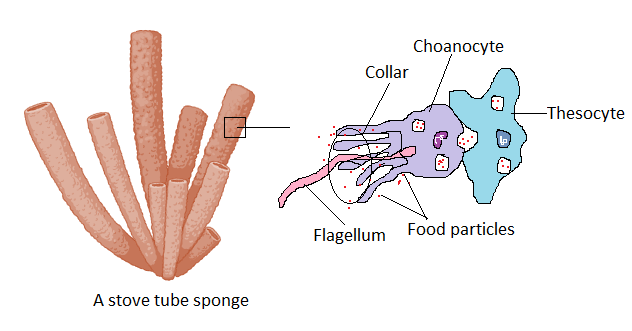
Which one of the following cells in sponges catch food?
A. Pinacocytes
B. Choanocytes
C. Thesocytes
D. Archaeocytes
Answer
558.3k+ views
Hint: Sponges are primitive organisms that belong to the phylum Porifera. They have a porous body and cellular level of organization. They have different types of cells for different functions. Flagellated cells that line the internal chamber of sponges are involved in catching food for sponges.
Complete answer:Sponges are marine primitive animals that have cylindrical porous bodies. They have simple cellular organization. The outer walls of the sponges surround the internal cavity. They are multicellular organisms. The pores and channels throughout their outer wall allow water and nutrients to circulate through them. They do not have nervous, circulatory, or digestive systems. They rely on the constant flow of water to obtain food and to excrete. The flowing water brings microorganisms that can be entrapped by specialized catching cells of sponges. These cells are flagellated and have a collar of protoplasm at the base of their flagellum. They line up the internal chamber of sponges. They are present along the spongocoel and the water canal system. These are called choanocytes. They also function as first digestion units as digestion in sponges is intracellular.

Let us discuss other types of cells that sponges consist of.
Thesocytes are specialized cells that are used to store food. These are types of amoebocyte cells. pinacocytes and porocytes line the outer dermal layer called pinacoderm. Trophocytes are cells where further digestion happens in sponges after choanocytes.
So, from the above discussion, we can conclude that the right answer is option B.
Note: Sponges consist of unspecialized cells that migrate between the main cell layers and mesophyll. These cells can transform to make any cell of the sponges. They can regenerate from the cut parts. The sponges are considered a common ancestor of all animals.
Complete answer:Sponges are marine primitive animals that have cylindrical porous bodies. They have simple cellular organization. The outer walls of the sponges surround the internal cavity. They are multicellular organisms. The pores and channels throughout their outer wall allow water and nutrients to circulate through them. They do not have nervous, circulatory, or digestive systems. They rely on the constant flow of water to obtain food and to excrete. The flowing water brings microorganisms that can be entrapped by specialized catching cells of sponges. These cells are flagellated and have a collar of protoplasm at the base of their flagellum. They line up the internal chamber of sponges. They are present along the spongocoel and the water canal system. These are called choanocytes. They also function as first digestion units as digestion in sponges is intracellular.

Let us discuss other types of cells that sponges consist of.
Thesocytes are specialized cells that are used to store food. These are types of amoebocyte cells. pinacocytes and porocytes line the outer dermal layer called pinacoderm. Trophocytes are cells where further digestion happens in sponges after choanocytes.
So, from the above discussion, we can conclude that the right answer is option B.
Note: Sponges consist of unspecialized cells that migrate between the main cell layers and mesophyll. These cells can transform to make any cell of the sponges. They can regenerate from the cut parts. The sponges are considered a common ancestor of all animals.
Recently Updated Pages
The number of solutions in x in 02pi for which sqrt class 12 maths CBSE

Write any two methods of preparation of phenol Give class 12 chemistry CBSE

Differentiate between action potential and resting class 12 biology CBSE

Two plane mirrors arranged at right angles to each class 12 physics CBSE

Which of the following molecules is are chiral A I class 12 chemistry CBSE

Name different types of neurons and give one function class 12 biology CBSE

Trending doubts
What is 1s 2s 2p 3s 3p class 11 chemistry CBSE

Discuss the various forms of bacteria class 11 biology CBSE

An example of chemosynthetic bacteria is A E coli B class 11 biology CBSE

Name the metals and nonmetals in the first twenty class 11 chemistry CBSE

Which one of the following is not a method of soil class 11 biology CBSE

What is the nature of force between two parallel conductors class 11 physics CBSE




